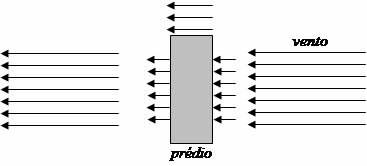Mathematical calculations are present in various everyday situations, for example, in the construction of a building, we use numerous calculations considered essential for the building's success. The amount of bricks, the thickness of the concrete beams and iron bars, the exact proportion of sand, water and cement, the depth of the trenches, among other situations. What we don't realize is that something very important in the construction of a building starts to be discussed at the moment of the project design, as every vertical construction must take into account the horizontal force imposed by the wind.
The force imposed by the wind is exponential, because as we double the wind speed, the force is quadrupled. For example, winds at a speed of 80 km/h generate a horizontal force of 360N/m² (Newton per square meter), in this case winds of the order of 160 km/h produce a force of 1440 N/m². Let's for example determine the force imposed on a building 400 meters high, which is 40 meters wide, hit by winds of 160 km/h.
The lateral area of the building will be given by 400 * 40, which results in 16000 m². Therefore, the horizontal force will be 16000 * 1440 = 23,040,000 N/m² or approximately 2348 tons. This force tends to destabilize the base and the higher the building the greater the wind speed.
The most interesting thing is that there are two forces acting at the same moment, one of them is pushing the building and the other appears pulling the building, as the airflow on one side generates a vacuum on the other side. Watch:
Do not stop now... There's more after the advertising ;)

In addition to the force of the wind acting on the building, there is the occurrence of oscillation movement, due to the fact that today's buildings are very light. But this problem can be solved with the use of very large concrete stabilizers located at the top of the building.

Swing Stabilizer of a Building
They work by moving against the oscillation imposed by the force of the wind. Watch:

by Mark Noah
Graduated in Mathematics
Brazil School Team
Trigonometry - Math - Brazil School
Would you like to reference this text in a school or academic work? Look:
SILVA, Marcos Noé Pedro da. "The Engineering of Large Buildings"; Brazil School. Available in: https://brasilescola.uol.com.br/matematica/a-engenharia-dos-grandes-edificios.htm. Accessed on June 27, 2021.

